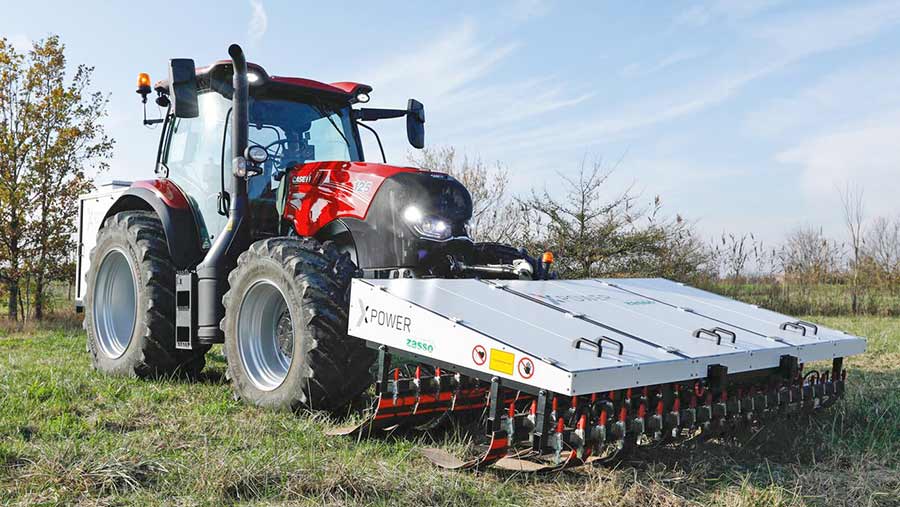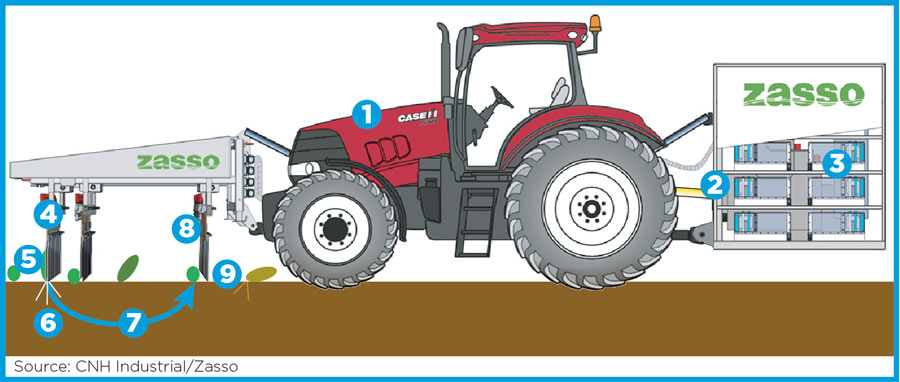Digital weed zapper offers alternative to chemical herbicides

A revolutionary new machine will be available in the UK from early 2019, offering an effective alternative to broad-spectrum herbicides used in tasks such as potato haulm desiccation.
Herbicide active diquat has been on the European regulatory radar for a number of years because of its perceived risk to sprayer operators, bystanders and residents, as well as birdlife.
See also: Arable Horizons: Biocontrol – will the holy grail become reality
The guillotine finally dropped last October as the European Commission (EC) confirmed its approval would be withdrawn, with sales ending on 4 February 2019 and a use-up date for existing stock exactly 12 months later.
It has a number of uses in the UK, including cleaning up stubbles, in pre-emergence herbicide mixes and desiccating a number of crops, including oilseed rape, peas and beans, linseed and various seed crops.
Potato woes
However, it is likely to be missed most by potato growers, as it provides a rapid burndown of haulm to stop tuber growth at a marketable size, induce skin set and prevent disease spread before harvest.
In addition to diquat, fellow broad-spectrum weed killer glyphosate may be safe from the chop in the short term, but there is still plenty of enthusiasm to see it taken off the market.
All this means the crop production industry is crying out for viable alternatives to these active ingredients. Luckily a new collaboration looks set to bring a highly charged option to the table.
CNH Industrial has entered a commercial agreement with German company Zasso to bring its digital weeder to the agricultural market across Europe. In the UK, it will be available through a network of specially selected dealers.

What is it?
The concept of electric weeding is not new, but previous incarnations have involved very high voltages being transferred into weeds, effectively cooking the plants to death.
With the brand name “XPower”, Zasso has developed a machine that instead of cooking the target with high temperature, transfers pulsating electricity at a particular frequency through the plant for a short time, destroying its vascular bundle (cells that transport water and nutrients). Each applicator is capable of generating up to 7,000v.
John Downes, precision farming specialist for CNH Industrial UK and ROI, explains that the XPower is unique in the world of organic weed control, as it works right down to the plant’s roots.
Other organic methods include burners and heat treatments generated by infrared/laser, hot water or hot air and only work at or near the soil surface, so Zasso’s concept is as close to a systemic herbicide treatment as you can get.
“At a recent demonstration of the XPower in Italy it was a hot and sunny day and after 10-15 minutes, weeds were already wilting, so response to the treatment is very quick,” adds Mr Downes.
XPower digital weeder – key points
- Non-chemical alternative to broad-spectrum herbicides and desiccants
- Works by transferring strong electric current through target plants
- Results can be seen in as little as 10-15 minutes in hot and dry conditions
- Active against all weeds in a range of conditions and is environmentally safe
- Provides an effective and crop safe method for potato haulm desiccation
- Future developments include wider machines and more targeted weed control
How does it work?
Although available in a smaller 1.5m version for municipal and horticultural use, the 3m Xpower will be of most interest to broad-acre growers in the UK and a diagram of how the machine works can be seen below.
Mechanical power is generated by the tractor (1) and a rear-mounted box containing a pto-driven generator (2) transfers it to high-frequency, high-voltage transformers (3).
Power is then transferred to an applicator on the front linkage via high voltage cables and connectors and a positive charge is channelled through two rows of offset paddles (4) that make contact with the ground across the width of the machine.
These pass electrical current through any plants on the soil surface (5) and down into their roots (6) and through the soil (7). A row of negatively charges paddles at the rear give a “double effect” on the weeds (8) before completing the electrical circuit (9).

How the Xpower works
What are the positives?
The XPower can control any size plant and isn’t reliant – like some herbicides – on plants being physiologically active to be effective. It can also be used at any temperature and is able to kill herbicide-resistant weeds.
From an environmental perspective, no soil movement will appeal to those in conservation agriculture systems and there are no chemical residues to boot.
Mr Downes says that although there is no requirement to assess the effects of thermal, physical or mechanic weeding on non-target organisms, Zasso has been proactive in assessing the machine’s effect through its development.
It has been found to have negligible implications for earthworm numbers. In trials, worm counts fell very slightly when compared with the control (no-till), with ploughing significantly more damaging to populations.
A similarly low impact was also seen when assessing for springtails and soil microbial activity.
How will it be used?
Smaller units are already being used to control weeds in municipal situations and CNH Industrial sees a big market for the XPower in vineyards and orchards, where producers are looking to reduce reliance on herbicides such as glyphosate.
Organic crop producers will be interested, as they have few alternatives other than mechanical methods to control weeds in stubbles, destroy cover crops or desiccate potatoes.
However, conventional potato producers are also likely to embrace the technology for haulm destruction after the loss of diquat. The efficacy of the machine was demonstrated at the recent Potato Europe event near Hanover, Germany.
Initial trials during the 2018 season have been successful, with the XPower managing to successfully destroy haulm without any crop quality issues.
However, as with any desiccation method, problems can’t be ruled out if used incorrectly. Shocking a stressed potato crop in dry conditions can result in vascular browning, an internal defect that sees marketability of tubers lost.
Mr Downes says a light treatment followed by a more robust one looks to be the most effective and safe method. The effect on tuber storage is being assessed over winter and more in-field work is planned next season.
Future development
Growers should see the width of the applicator increase from 3m to 6m relatively quickly, helping to up work rates of a machine that typically travels at just 4-6kph.
In the longer term, Mr Downes says the collaboration will look to incorporate the latest artificial intelligence and camera technology, allowing the XPower to recognise specific weeds and take them out of growing crops.
With the price of a 3m machine between €170,000 and €190,000, ownership is likely to be confined to large-scale or contracting businesses.
In a twist on normal machinery purchasing models, end users – whether owners or farmers paying for the XPower service via a contractor – will also have to use a pre-pay system, whereby they top up an account with credit.
Telematics will then track power consumption (in kW/h) or area covered and charge accordingly.
Mr Downes says huge investment has gone into the development of the technology, so this is a way of Zasso getting a return on investment for its intellectual property.
“There is no XPower currently on UK soil, but two are working in mainland Europe. If there is enough interest, CNH Industrial will be happy to take potential customers over to Austria or Germany to see the technology in action,” he adds.

